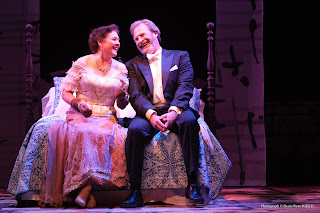For the in-person part of its May Music Festival, EMS ends triumphantly with Ying Quartet's Beethoven
Surely in the top rank of violinists to come out of Indianapolis, Robin Scott returned this week under
 |
| The Ying Quartet celebrated return to live action here. |
Ensemble Music Society auspices as first violinist of the Ying Quartet. He's held the position since 2015, about as long as his two immediate predecessors combined.
His presence nowadays has an air of permanence about it, as only founding member Timothy Ying played with his siblings in the eminent American string quartet longer than Scott.
Certainly the mutual rapport of the players was evident in performances Thursday evening of two major Beethoven string quartets: Opus 59, No. 3 ("Razumovsky") in C major and Opus 131 in C-sharp minor. The response of the pandemic-restricted audience at Glick Indiana History Center was ecstatic.
To take up the less problematic work first: the Third Razumovsky is an elfin, volatile delight. The tense first-movement introduction gives little hint of the buoyancy to come, but it was fully engaged in by the Ying ensemble. Similarly, the hushed coda of the third movement was carried out with due solemnity before all shadows were swept away by the whirlwind finale. That Allegro molto inevitably has an airborne quality, but I noted with particular satisfaction the way the Ying Quartet found subtleties and textural variation without allowing the energy to slacken.
This performance went far to dispel the unpleasantly dizzying effect a film of this movement once had on me. It was part of a feature on the Guarneri Quartet of hallowed memory. Seeking a visual counterpart to the music's galvanic momentum, the cameras revolve around the quartet in a headlong rush to complement what the players are producing. It reminded me why I've never gone in for amusement-park rides that operate in a similar fashion. All the excitement needed can be heard in what the Ying did while I was watching Scott, second violinist Janet Ying, violist Philip Ying, and cellist David Ying from a stationary position.
In his ingratiating remarks from the stage before the performance, Scott mentioned at the end that "the Beethoven quartets need no explanation." There is ample truth in a reminder that music designed to communicate gets much of its meaning across without words, even to attentive first-time listeners. So I'm quite at peace with any musician's making such a statement, but it's a tad ironic in this case, especially where Beethoven's late string quartets are concerned.
 |
| Brooklyn Rider waxed poetic. |
This one, in seven linked movements, has occasioned an abundance of explanation. Some claims made for it put the C-sharp minor quartet on the loftiest spiritual plane. In notes to its 2012 recording of the piece, Brooklyn Ryder refers to the work's "near-impossible musical juxtapositions," alluding no doubt to such matters as the tempo fluctuations in the finale, where "a tempo" sits cheek-by-jowl with "ritardando" repeatedly. The Ying players made sure such variations were there without suggesting that Beethoven just couldn't make up his mind. Everything cohered; a confident spirit prevailed. I especially liked the way the final three chords of equal value were enunciated without sounding like a trivializing "cha-cha-cha."
The music also puts in close proximity the simplest, catchiest tunes with gnarled passages and insistence on exploring the hidden implications of the main material. I imagine Beethoven saying, in the course of the 40-minute work but especially in the seventh movement: "It's really all about simplicity, isn't it? But life keeps throwing complications at us. We must learn to handle them in order to understand that fundamental simplicity." That must be why Brooklyn Rider notes: "Beethoven forces us to rise to no less than our full potential, to interact with each other and society on equal terms, to love and to be vulnerable." A guide to how to live our lives? Really? It's a hard notion to dismiss.
So potentially tangled are the music's inner workings that a full chapter in "The Art of Quartet Playing" is devoted to how the Guarneri arrived at their interpretation of the piece, including decisions to tweak Beethoven's directions in order to improve balances. The irrepressible Guarneri seems to have tied itself in knots over op. 131, then untied the knots. Presumably the Ying did the same, though not every ensemble gets into the weeds the same way.
Interviewer David Blum ends his book with post-performance responses of Guarneri members to that problematic finale: "Savage — utterly savage," "grotesque and wild," "a demonic dance — and yet, what wonderfully tender moments, what an enormous emotional range!"
I hesitate to ascribe similar summings-up to the very able Ying musicians, but I'll leave the Guarneri violinists with the last word, which I trust may apply to what last night's audience felt as well: Arnold Steinhardt: "He's shaking his fist at destiny. It's terrifying — but suddenly everything is released and it overflows with joy, with ecstasy." John Dalley, less loftily, but still somehow apropos: "You want to bark like a dog."
Kudos to Ensemble Music Society and the Ying Quartet for addressing our spiritual and animal natures alike.
[Photo by Tim Greenway]


Comments
Post a Comment